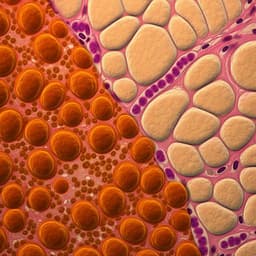
Physics
Single-domain stripe order in a high-temperature superconductor
G. Simutis, J. Küspert, et al.
Investigating the intricate relationship between charge and spin in cuprate high-temperature superconductors, researchers have uncovered a fascinating coupling effect that responds to uniaxial pressure. This groundbreaking study, led by Gediminas Simutis and colleagues, opens new avenues for understanding charge-spin stripe fluctuations essential for high-temperature superconductivity.
~3 min • Beginner • English
Introduction
The study addresses how charge-density-wave (CDW) and spin-density-wave (SDW) degrees of freedom are microscopically coupled in cuprate high-temperature superconductors and whether they are merely coexisting phenomena or directly intertwined. Prior work indicates near-degenerate ground state energies of static CDW, SDW, and unconventional superconductivity, with density-wave orders most robust near p ≈ 1/8 hole doping, where superconductivity is suppressed. In La-based cuprates, static CDW and SDW orders can coexist and show signs of coupling, whereas in YBa2Cu3O7−y they appear mutually exclusive. In La2−xSrxCuO4 (LSCO) at x ≈ 0.12, SDW onsets near T ≈ 25–27 K, while short-range CDW persists above 100 K, and coexistence of static SDW and CDW occurs only for ~0.1 < x < ~0.135. The central hypothesis is that if CDW and SDW are directly coupled as stripes, then an external uniaxial tuning parameter should affect both in the same manner and may create a single-domain stripe state. The study’s purpose is to use uniaxial pressure along the Cu–O bond in LSCO x = 0.12 and sensitive elastic neutron scattering to test for single-domain SDW formation and thereby probe the coupling between charge and spin orders. This has importance for constraining microscopic theories of high-Tc superconductivity that invoke intertwined charge-spin stripe fluctuations.
Literature Review
- Theoretical and experimental studies suggest near-degenerate energies among CDW, SDW, and d-wave superconductivity in the cuprates, with fluctuating stripes observed in Hubbard-model simulations and experiments (refs 1–9).
- Density-wave orders peak in stability at p ≈ 1/8 doping where superconductivity is suppressed; in YBa2Cu3O6+x, static CDW and SDW tend not to coexist (refs 10,11), in contrast to La-based cuprates where they can coexist and show coupling signatures (refs 1,2,9).
- In LSCO, SDW order is strongest near x ≈ 1/8 with T_N comparable to Tc (~25–27 K), while CDW correlations persist to higher temperatures (>100 K) (refs 3,12). Static coexistence is limited to ~0.1 < x < ~0.135, raising questions about a common quantum critical point (refs 3,14–18).
- Recent x-ray scattering under uniaxial strain along the Cu–O bond in LSCO x = 0.12 showed suppression of one CDW domain with reversible recovery after strain release, implying strain-tunable CDW domain population (ref 19) and, with further work, stripe order rotation (ref 24).
- Competing models: strong-coupling stripe picture with δ_CDW = 2 δ_SDW from holes located at antiphase SDW domain walls (refs 1,7,8,45,46) versus weak-coupling nesting scenarios (refs 47,48). Multi-Q patterns (checkerboards, spin-vortex checkerboards) have been proposed but remain debated (refs 29–39).
Methodology
- Strategy and instrumentation: To probe weak SDW order under uniaxial pressure in tiny LSCO crystals, the study combined (i) McStas Union-component neutron ray-tracing simulations including background from sample environments to optimize signal-to-background and identify benefits of longer neutron wavelengths; (ii) use of the ThALES cold triple-axis spectrometer (ILL, Grenoble) with adaptive virtual source and double-focusing Si(111) monochromator for superior beam focusing; and (iii) a scaled-up, low-background uniaxial pressure cell tailored for neutron experiments (aluminium body, Cd masking) enabling application of uniaxial pressure along the Cu–O bond.
- Samples: High-quality LSCO x = 0.12 crystals grown by travelling solvent floating zone. Two samples prepared: 1.060 g (ambient-pressure benchmark) and 0.055 g cuboid (≈3.17×1.35×1.83 mm³) for strain measurements. Superconducting Tc ≈ 27 K (magnetization). MuSR characterized magnetism consistent with prior LSCO studies. Crystallinity verified by x-ray Laue and neutron instruments; the small sample single crystalline within resolution; the larger composed of two slightly misoriented crystallites (5:1 intensity ratio, 1.5° offset).
- Uniaxial pressure application: Compressive strain ε ≈ 0.02% applied at room temperature along the a-axis (Cu–O bond) via an M3 aluminium screw rotated by 60°, calibrated per ref. 19. The strain cell was designed with open geometry and high-purity aluminium to minimize background.
- Neutron scattering conditions: Measurements on ThALES with k_i = k_f ≈ 1.55 Å⁻¹ neutrons; higher-order contamination suppressed with velocity selector and cooled Be filter; double-focusing PG(002) analyzer; W-configuration to minimize resolution ellipsoid; detection with a 1-inch ³He detector. Samples oriented with c-axis vertical to access both SDW domains in the scattering plane. Signal-to-noise optimized via virtual slit positioning/opening (≈8 mm) and tight slits before/after the sample.
- Measurement protocol:
- Ambient-pressure (1.06 g sample): Elastic scans at T = 2 K across incommensurate SDW wavevectors Q_SDW = (0.5 ± δ_spw, 0.5, 0) and (0.5, 0.5 ± δ_spw, 0) in tetragonal notation; Gaussian fits on sloping backgrounds extracted δ_spw and in-plane correlation length ξ_∥.
- Strained (0.055 g sample): Compressive a-axis strain applied; reciprocal-space scans across the two SDW wavevectors at T = 2 K and T = 40 K (above T_N) with 40 K data defining background (sloping). High counting statistics enabled detection of magnetic signals down to ~2% above background. Gaussian fits over fixed high-T backgrounds quantified peak parameters. Temperature-dependent intensities of the two SDW positions tracked to determine T_N and domain population changes.
- Data analysis: Intensities normalized per sample mass (cts/(s·g)) to enable comparison across samples and conditions. Background subtraction performed to determine integrated intensities I_int (cts-rlu/(s·g)). In-plane correlation length computed as ξ_∥ = (α/π)·FWHM⁻¹. Y-shift (perpendicular incommensuration) assessed from off-axis scans. Auxiliary details provided in Supplementary Information (SI Notes).
Key Findings
- Ambient pressure (T = 2 K, 1.06 g sample): Clear magnetic peaks at both incommensurate SDW positions, consistent with two orthogonal stripe domains (or multi-Q scenarios). Gaussian fits yield δ_spw = 0.118(4) rlu and in-plane correlation length ξ_∥ = 67(9) Å. A small perpendicular incommensuration (Y-shift) of 0.007(2) rlu observed. Background-corrected integrated intensities: I_int ≈ 0.030(3) and 0.015(3) cts-rlu/(s·g) for the two symmetry-related SDW peaks.
- Under uniaxial compressive a-axis strain ε ≈ 0.02% (0.055 g sample): A single SDW domain survives. No detectable magnetic peak at Q_SDW corresponding to the domain aligned with the pressing direction down to ~2% above background; a robust peak (~8% above background) remains at the orthogonal SDW wavevector. Fit results: δ_spw = 0.118(2) rlu and ξ_∥ = 66(13) Å (unchanged from ambient). A small Y-shift persists at ~0.005(1) rlu. Background-corrected integrated intensity at the surviving SDW wavevector increases to I_int = 0.07(1) cts-rlu/(s·g).
- Temperature dependence: SDW onset temperature T_N ≈ 25 K is unchanged by strain. Peak positions and correlation lengths are unchanged by strain, indicating domain repopulation rather than modification of the intrinsic SDW order parameter.
- Domain selection: Pressure along one Cu–O direction favors an SDW domain with propagation vector along the perpendicular Cu–O direction, evidencing a single-Q magnetic structure and ruling out multi-Q single-domain states (e.g., spin-vortex checkerboards).
- Consistency with CDW response: Prior x-ray studies (ref 19) under similar uniaxial strain showed suppression of one CDW domain and reversibility upon strain release. Identical tuning of SDW and CDW by uniaxial pressure supports an intertwined charge–spin stripe state with δ_CDW = 2δ_SDW.
Discussion
The experiments directly address whether CDW and SDW in LSCO x = 0.12 are coupled by testing their response to a uniaxial tuning parameter. The observation that weak compressive strain along the Cu–O bond eliminates one SDW domain while enhancing the orthogonal domain, with unchanged δ_spw, ξ_∥, and T_N, demonstrates domain repopulation and a single-Q magnetic structure. This behavior mirrors the CDW’s uniaxial strain response reported previously, indicating that charge and spin stripes are intertwined and share the same unidirectional domain selection under strain. The results are naturally explained by a strong-coupling stripe picture in which holes reside at antiphase SDW domain boundaries, enforcing δ_CDW = 2δ_SDW and linking charge and spin orders in direct space. In contrast, weak-coupling Fermi-surface nesting scenarios would require finely tuned anisotropic distortions to affect CDW and SDW identically and would likely produce strain-induced shifts of ordering vectors, which are not observed. The findings also have implications for pair-density-wave (PDW) proposals: if superconductivity intertwines with stripe order, a PDW component would inherit the uniaxial stripe character and remain robust under such strain. Comparisons with LBCO, where different stress directions can enhance competition between superconductivity and magnetism, suggest that the interplay among stripes, superconductivity, and lattice anisotropy is material- and direction-dependent, motivating systematic uniaxial studies across cuprates.
Conclusion
This work establishes that uniaxial pressure along the Cu–O bond in LSCO x = 0.12 selects a single spin-stripe domain without altering the SDW wavevector, correlation length, or onset temperature, and that SDW responds to strain identically to CDW reported previously. The results provide direct evidence for intertwined, unidirectional charge–spin stripe order (single-Q) and rule out multi-Q single-domain scenarios. Methodologically, the study demonstrates that next-generation, highly focused cold-neutron triple-axis spectroscopy, coupled with low-background uniaxial pressure cells, enables sensitive measurements of weak magnetic order in tiny crystals. These insights constrain theories of high-Tc superconductivity to incorporate uniaxial stripe fluctuations of charge and spin. Future work should probe different strain directions and magnitudes, map broader doping/temperature ranges, and extend to related cuprates (e.g., LBCO) and other correlated materials to elucidate how stripe order intertwines with superconductivity and possible PDW states.
Limitations
- Measurements were performed at a single composition (LSCO x ≈ 0.12) and primarily at low temperatures; generalization across doping and temperature requires further work.
- The applied strain was small (ε ≈ 0.02%) and along one crystallographic direction (a-axis); responses to other magnitudes and directions were not explored here.
- The small sample size necessitated specialized instrumentation and limits absolute intensity comparisons; mass-normalization and background subtraction mitigate but do not eliminate such constraints.
- CDW order was inferred from prior x-ray results under similar conditions rather than measured simultaneously with neutrons in this experiment.
- Multi-domain crystallinity in the larger ambient-pressure sample (minor second crystallite) could introduce subtle systematic uncertainties, though the strain sample was single crystalline within resolution.
Related Publications
Explore these studies to deepen your understanding of the subject.







